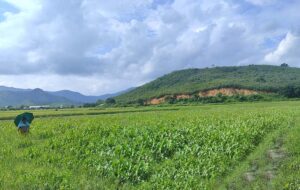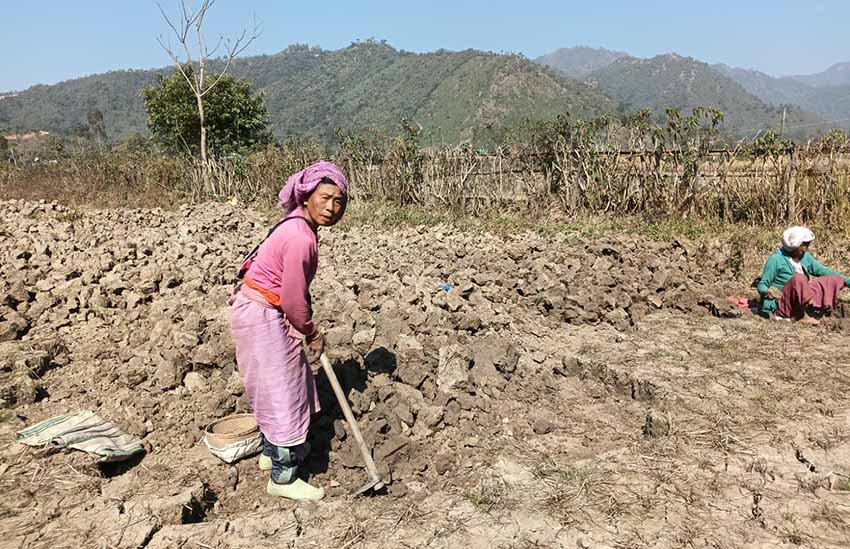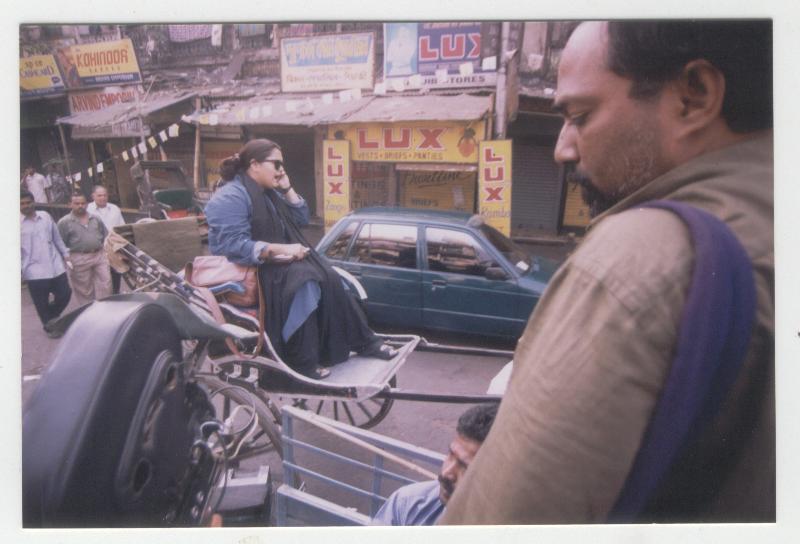‘All my efforts to plant paddy was in vain because of the prolonged water logging in my field. I was waiting for several days to plant my paddy but it was not possible at all to do so. When the water level receded, I saw many Koukha plants growing up plenty in my field’ narrated by Ngangom Rajen (65yrs), a farmer of Nungsum of Imphal East, Manipur who has been cultivating Koukha for the last 20 years. Suddenly a seed of hope budded in his mind to cultivate Koukha. Starting from that particular year till now he started cultivating Koukha in his field instead of cultivating paddy, he expressed. He could earn fifteen thousand rupees (Rs.15000) at the ever first year. That added him to expand and put more efforts in planting more Koukha plants in his field. Before that he had already conceived the idea of planting Koukha but considering paddy as our staple crop he did not attempt to plant Koukha in his field.

Ngangom Rajen who is a successful farmer in planting Koukha said that plantation starts from the month of June-July and harvesting from the month of October-November. In one Sangam of area he could make a minimum profit of one lakh rupees (Rs. 100000) easily in a year. But for this year with more rainfall and frequent floods, the product seems to be smaller and less productive making less profit unlike previous years. Explaining the reason for the shift of cultivating, he told that planting paddy is more expensive with low productive. But planting Koukha could make multiple profits for farmers in the state. He shared his experiences and knowledge to other farmers who are interested in planting Koukha. Now, he started supplying saplings to many farmers. For this season he could sell the saplings for four lakhs rupees with a profit of two lakhs and fifty thousand rupees.
Koukha or Arrow head is botanically known as Sagittarie sagittifolia. It belongs to the family Alismataceae (Monocotyledonous). It is an aquatic perennial with wintering tubers. It is native to Europe and Asia commonly found in shallow waters, marshes and ponds. It is widely grown in the valley areas of Manipur particularly in wetlands and paddy fields. It is used and consumed for its traditional medicine properties. Koukha is consumed in Manipur in boiled or roasted, curry with other local ingredients or as bora (a type of fritters) etc.
Talking to IRAP, another farmer Heikham Ngouba of Yumnam Khunou Awang Leikai, Imphal East expressed that he started planting Koukha since 2024 in his one Sangam area for the first time. He bought the saplings from Nungsum and Sinam Kom at the rate of one rupee per sapling spending around Rs. 23000 (Rupees twenty three thousand). Till January 2025 he could harvest more than 300 kilograms of Koukha and many more to harvest. He estimated that around 1000 kilograms could be harvested for this season. In his one Sangam of area he could harvest maximum of (27 to 28) bags of paddy a year of an amount of around thirty thousand rupees. And moreover it is hard to make profit in planting paddy as it is more expensive and laborious. He is expected to earn an amount of Rs 80,000 by selling at Rs 80 per kilogram. With less efforts and more profit, Ngouba preferred Koukha than paddy. He had stopped planting paddy in his field. By this new practice of agriculture it offers part time employment to some people by giving 50 rupees per kilogram of harvest. For the next season, he will put more efforts and consult with experts to make more profit, he added.
Kharibam Rajen Meitei (61 years) another farmer from Ishikha Mayai Leikai, Imphal East who has the experienced of planting Koukha for the last five to six years asserted that planting Koukha in one Sangam of area could make a profit of around two lakhs rupees. It is very hard even to make a profit of 30 thousand rupees in planting paddy. After harvesting the paddy he planted potatoes in his farm for last many years. But he could not make a maximum profit as his field endured frequent floods destroying the potatoes plant. And moreover the decreasing fertility of soil could not yield good quality of paddy and other crops. With this change in soil fertility Rajen found his field more suitable for planting Koukha with a maximum profit.
In recent years, Manipur has witnessed a gradual shift from traditional paddy to Koukha. This transition is influenced by multiple factors including climate change, water scarcity, soil degradation and economic viability. In this regard, Prof. A Nabachandra, Head Department of Agronomy, College of Agriculture, Central Agricultural University, (CAU) Imphal said that because of climate change the intensity of rainfall is very high and disturbance of rainfall pattern causing flash floods. With the high intensity of rainfall at a particular period of time the low lying areas faces flash floods frequently which is not favorable for growing paddy plants. This situation makes the farmers repeat their plantation many times. Such situation hardly occurred in the past in the state. Even in the last year farmers of the state experiences more than three floods in their paddy field which compelled them to repeat their crops with a big lost. In such submergence conditions planting such as Koukha can grow well, he added.
Mentioning about the shift in the agricultural practices in the state Professor Nabachandra said that with the decreasing in the depth of the wetland particularly in Loktak lake the water holding capacity decreases thus spreading the water to its peripheries which is again not favorable for growing paddy. In such condition, Koukha can be a substitute plant for the farmers. Farmers can cultivate Koukha in these places as it can tolerate the water level unlike paddy. Moreover there are reports that Koukha has the property of fixing nitrogen like other leguminous plant which support in increasing the fertility of the soil.
With the change in the rainfall pattern due to climate change farmers could not make a profit with the paddy plantation. But for states like Punjab and Haryana with full irrigated conditions farmers do not face problems as farmers of the state. There is a specific period for planting paddy plants. As Manipur is a rain fed state, farmers have to wait for the rainfall for all the activities related with plantation of paddy plants. With the late planting of any plants including paddy, the productivity rate also lower down. This is one such factors that the farmers faced frequently every year in the state, he mentioned. As planting paddy is more labourious, hardship intensive crop and with the increase in the labour cost and with less profit, farmers have shifted the crop with high value such as Koukha. One advantage of Koukha unlike paddy is it can be harvested phase wise for many months. It can be harvested from December to March. It may be calculated that the profit of planting Koukha is triple times that of paddy plants. This is one advantage of Koukha plantation. He suggested farmers to follow more scientific techniques of cultivating Koukha for more sustainable farming in the state. The shift from paddy to Koukha in Manipur is a response to environmental challenges and economic opportunities. It can contribute to a more resilient and sustainable agricultural system in the state.
(The article is filed under the 5th State Level Media Fellowship Programme on Climate Change under the sponsorship of Directorate of Environment and Climate Change, Government of Manipur.)












